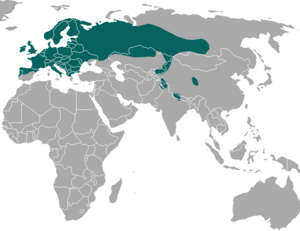Eurasian pygmy shrew facts for kids
Quick facts for kids Eurasian pygmy shrew |
|
|---|---|
 |
|
| Conservation status | |
| Scientific classification | |
| Genus: |
Sorex
|
| Species: |
minutus
|
 |
|
| Eurasian pygmy shrew range | |
The Eurasian pygmy shrew (Sorex minutus) is a tiny, active mammal. It is also known simply as the pygmy shrew. You can find this widespread shrew across the northern parts of Europe and Asia.
What Does It Look Like?
This little shrew is about 5 centimeters (2 inches) long. Its tail adds another 3.5 centimeters (1.4 inches) to its length. An average pygmy shrew weighs only about 4 grams (0.14 ounces). That's less than a U.S. nickel!
Its fur is very dense and shiny. The hair on its back is blackish, sometimes with reddish or purplish shades. Its belly, throat, jaw, and the area around its eyes are whitish. The lower part of its tail is also whitish. Its nose and legs have a few white hairs, and its skin is flesh-colored. Its ears are small and mostly hidden by its fur. They are dark and shaped like a half-circle. This shrew has a head that looks quite large compared to its body.
It can sometimes be hard to tell apart from other shrews. These include the Eurasian least shrew and the Etruscan shrew.
How Does It Live?

Eurasian pygmy shrews live alone. They are active all day and night. They prefer to live in places with lots of thick plants. You can find them at many different heights, from lowlands to mountains.
They eat seeds, small insects, and other tiny creatures without backbones. Pygmy shrews often use tunnels or burrows made by other small animals. If they dig their own homes, they usually burrow under tree stumps. These tiny animals have many predators, like owls and foxes. They spend their whole lives in a small area, only a few hundred square meters wide. Within this area, they create their own pathways.
The Eurasian pygmy shrew has a very fast metabolism. This means its body burns energy very quickly. To stay healthy, it must eat every two hours! Because of this, it eats a lot. It can eat up to 125% of its own body weight each day. That's like eating more than its entire body weight in food! They are active for short bursts, about 15 minutes. Then they rest or sleep for about 15 minutes before becoming active again. This cycle repeats all day long.
Reproduction
The breeding season for these shrews runs from April to August. Female shrews usually have between two and eight babies in each litter. They raise their young in a nest built underground.
The mother is pregnant for just over three weeks. This means she can have up to five litters in one year! However, a pygmy shrew's life is quite short. Most live for only a little over 15 months.


